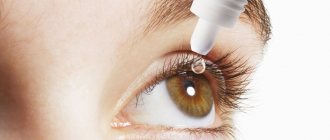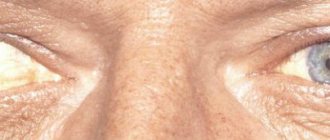According to statistics, the largest number of cases of blindness develops as a result of cataracts - clouding of the lens, although treating the disease does not present any difficulties. The question arises, how to stop the initial cataract?
70% of patients go from the first manifestations of the disease to vision loss in 7-10 years. The remaining 30% is divided equally among those who:
- the disease progresses rapidly (the lens is filled with vacuoles within 5 years);
- Symptoms increase slowly (over 12-15 years).
The rate of development of pathology can be corrected to a certain extent by taking medications, proper visual hygiene, observing a rest and work schedule, taking vitamins, etc.
What is cataract
Most often, as a result of age-related changes in the body, cloudiness appears in the lens and vision deteriorates. Symptoms are caused by a change in the ability of the damaged organ to transmit and refract light. Cataracts at the initial stage are characterized by mild symptoms. Destruction begins with the appearance of protein deposits on the lens. In patients with hypermetropia, a temporary improvement in vision is possible, which eliminates the need to wear corrective glasses. They can read and see small objects. The main risk factors that provoke clouding of the lens are old age, hereditary predisposition, and being female. It has been noted that people with brown eyes get sick more often than those with light eyes.
Diagnostics
Senile cataract: diagnosis Diagnostic measures usually include an external examination of the eyes and the use of instrumental methods. The doctor will also ask the patient about complaints.
Special methods:
- Visual acuity test. Tables and refractometry may be used. It must be remembered that impaired visual acuity is a nonspecific sign for cataracts. This symptom may indicate other diseases.
- Examination of the eye using a slit lamp. The doctor uses a microscope and special equipment to examine the cornea, iris, and lens. Typically, this examination reveals the characteristic signs of cataracts.
- Tonometry. Measuring intraocular pressure is also important for diagnosis.
- Retinoscopy. The doctor uses eye drops to dilate the pupil. A retinal examination is necessary to rule out other diseases.
Diagnosing cataracts can take no more than five minutes. It is recommended to undergo the listed studies at least once a year.
Reasons for the development of the disease
Pathological processes are triggered when age-related changes appear in the visual organ - the older the person, the larger the size of the lens. Over time, it thickens and becomes heavier. Also, damage of a symmetrical or asymmetrical nature occurs as a result of dysfunction of the endocrine system, long-term use of a certain group of medications, or the presence of toxins in the body.
Factors leading to the development of cataracts:
- regular exposure to ultraviolet rays or infrared radiation;
- genetic and congenital abnormalities;
- premature birth (damage to the baby's retina);
- long-term treatment with corticosteroids;
- penetrating eye injuries;
- increased blood sugar levels;
- chronic iridocyclitis;
- incomplete removal of lens masses during extracapsular extraction.
Classification
Lens opacities are classified according to different criteria.
According to morphological characteristics:
- Anterior or posterior subcapsular cataract. The peculiarity of this form is that the clouding begins in the space under the lens capsule.
- Nuclear. The formation of nuclear cataracts in the eyes of the elderly begins from the nucleus of the lens. The senile nuclear form is accompanied by thickening of the natural lens substance and signs of myopia. If the nucleus becomes brown or black in color, then a diagnosis of “brown cataract” is made.
- Cortical or cortical cataract. This option is the most common. Includes opacification of the posterior, anterior and equatorial parts of the capsule.
- Herringbone. The rarest option, characterized by deposits in the lens in the form of multiple small needles.
According to the degree of progression of turbidity:
- Initial, or immature cataract. Some authors divide this species into two separate ones. Initial changes in the lens begin with erased symptoms. A person sometimes does not even attach importance to mild changes in vision.
- Mature. Characterized by more pronounced clouding of the natural lens.
- Overripe. There was complete opacity, the anterior capsule shriveled. The visual functions of the eye are significantly impaired. The overripe senile form includes blinking cataract, when the cortical layers liquefy and the lens nucleus floats in them.
Main symptoms
At the initial stage of cataracts, there is no significant decrease in visual acuity, and other signs do not appear in any way. Therefore, patients do not rush to see an ophthalmologist, because they do not even assume that the disease has already begun to progress. The reason for a visit to the clinic later becomes the noticeable effect of cataracts on the eyeball, when vision begins to deteriorate. At this stage, clouding is detected in the outer parts of the lens; the central part is rarely affected.
Symptoms of eye pathology and the degree of their severity depend on the size of the clouding. If any signs appear, you should immediately visit a specialist:
- doubling of objects before the eyes;
- black dots, rainbow circles;
- the formation of a halo around the light source;
- colors are difficult to distinguish;
- vision decreases in low light.
People with age-related myopia experience improved vision. This is caused by swelling of the lens and a corresponding increase in its ability to refract light. Late stages are characterized by vision problems due to thickening of the lens and changes in refractive indexes.
Symptoms
The disease can result in serious vision problems, so the prevention of cataracts is of particular relevance. The disease has several degrees of damage, depending on which various symptoms and manifestations are observed:
- The appearance of a split effect and blurred vision at the moment when one eye is closed.
- Blurry objects, lack of clarity. Wearing glasses and contact lenses does not affect this defect.
- Observing symptoms of myopia.
- Frequent glare, which is mostly typical for the night time.
- Increased sensitivity to bright light.
- Color vision impairment.
Is it possible to stop cataracts at an early stage?
The disease most often affects patients over 50. Early age-related cataracts account for about 10% of all cases - the older the person, the higher the risk of developing pathological changes in the lens. The category of people over seventy years of age with visual problems due to cataracts is about 46%. Ophthalmologists consider protein deficiency of the eyeball and metabolic disorders to be factors causing eye dysfunction. But these are not the only reasons, there are others:
- alcohol abuse, excessive smoking;
- eye injury;
- thyroid function disorder;
- high blood sugar;
- Down syndrome;
- burn of the mucous membrane of the eye, often obtained in the active sun, if you do not wear sunglasses;
- glaucoma;
- retinal detachment;
- congenital lens anomalies formed in the embryonic period;
- anemia;
- inflammatory process in the vessels of the eye;
- systematic exposure to elevated temperatures, for example, due to professional activity;
- genetic predisposition;
- acute or chronic inflammation of the periphery of the vascular system;
- severe poisoning;
- skin diseases;
- high myopia.
People who experience symptoms of cataracts should consult an eye doctor. It is impossible to prevent cataracts. In the initial stages, therapeutic drug treatment is prescribed. Despite the fact that many argue that medications will slow down pathological processes and allow surgery to be postponed. In practice, the effectiveness of such drugs has not been proven.
Cataracts, unfortunately, cannot be treated conservatively. It can only be eliminated surgically. Phacoemulsification is considered the most effective - the affected lens is removed through a microincision, and an implant - an intraocular lens (IOL) - is placed in its place. This is the only way to restore clarity of vision to an elderly person.
Rate of progression
Based on the results of observations, experts note that the first signs of the development of age-related cataracts can appear as early as 40-50 years of age. The group of 60-70 years old accounts for up to 70% of diagnoses. The course of the disease and symptoms depend on the speed of development of the pathological process occurring in the lens.
By speed they are distinguished:
- Rapid cataract – its duration is 4-6 years. You should consult a doctor immediately after detecting a problem such as loss of visual acuity. The main type of treatment is surgery. This type of progression is observed in 12% of cases.
- Moderately current cataracts develop over a long period of time – 7-10 years from the moment the first symptoms appear. This type is the most common, occurring in 70% of patients.
- The slow rate of progression is 10-15 years. It is recorded in 18% of people with initial symptoms of an ophthalmological problem.
It is recommended to diagnose cataracts and begin the treatment process at an early stage, when surgery is not required. Based on the rate of progression, the disease is divided into initial, immature, mature and overripe cataracts. In each of these types, the clouding of the lens is different.
Treatment of the initial stage of cataracts
Non-surgical methods of combating initial cataracts include drug treatment, taking vitamin complexes and various diets. But you need to understand that if a cataract is diagnosed, it will develop and this process cannot be stopped.
The conservative method involves the use of various biologically active substances that act as blockers of eye lens abnormalities. One part of them is available in the form of drops. The other is in the form of injections, administered intramuscularly.
Complexes of vitamins and minerals are aimed at normalizing metabolic processes in the eyeball. They necessarily contain taurine and adenosine, as well as other elements that have a beneficial effect on the lens. What the doctor may prescribe:
- "Facovit." The medicine is sold in pharmacies in the form of drops and is intended to improve metabolism and block an increase in the area of lens clouding.
- Quinax.” In the case of cataracts, this drug is most often prescribed by an ophthalmologist. It eliminates symptoms well, prevents oxidation of the lens, and improves metabolism.
- "Taufon". Stabilizes metabolic processes and stimulates regenerative processes in the body. Protects the eye from pathogenic microflora, which can cause infection and other complications.
- "Catarax". The medication prevents the spread of clouding and destruction of the lens by slowing down protein reactions (protein is the main component of the eyeball). Drops trigger active metabolism, accelerating the regenerative function of the visual organ. Allowed for use during pregnancy and lactation.
It is not recommended to use medications on your own initiative. The type and dosage should be prescribed exclusively by the attending physician, taking into account the individuality of each case and contraindications.
Treatment of initial cataracts also includes diet. It consists of limiting foods and dishes high in fat - they increase cholesterol in the blood. You need to eat red fish, black currants, and spinach. These products contain a lot of vitamins C, E, and omega-3 fatty acids that are beneficial for vision. They delay the development of eye diseases and have a beneficial effect on the entire body.
How to treat cataracts in old age?
All types of this disease require surgical treatment, including the age-related form. Only by removing senile cataracts and replacing the lens with an artificial lens (IOL) can a significant improvement in visual function be achieved.
Surgical treatment
Surgical treatment of cataracts in elderly people can be started in the absence of contraindications. Before the expected date of surgery, all diseases of the internal organs must be compensated, blood pressure returned to normal, and glucose levels stabilized. There should be no acute infectious and inflammatory pathologies of the eye or internal organs.
Types of cataract surgery in old age:
- Phacoemulsification of cataracts (FEC) with IOL implantation. This is the most popular, safe, low-traumatic operation. The method involves destroying the lens using ultrasound energy (ultrasonic FEC) or laser (laser FEC). The lens, crushed to an emulsion, is removed and replaced with an intraocular lens. Sutures are not required, since surgical approaches are minimal and heal on their own.
- Extracapsular extraction. The operation is performed using surgical instruments. An incision is made on the cornea up to 9 mm, the clouded eye lens is removed, preserving the capsule, and replaced with an artificial one. Stitches are required, which are removed after 3-4 months.
- Intracapsular extraction. This type of operation is rarely used due to the high risk of complications. The essence of the method is to remove the lens according to the principle of extracapsular extraction, only together with the capsule.
Elderly people can receive treatment for senile cataracts free of charge under the compulsory medical insurance policy. To do this, you need to go to the clinic at your place of residence.
Additionally, see the review on the surgical treatment of a clouded lens:
Conservative therapy
Medicines are prescribed to slow the progression of senile changes, as well as for the period while surgery is contraindicated. The course is long - several months of daily instillation of drops.
Recommended drops: “Taufon”, “Vita-Yodurol”, “Oftan-Katakhrom”, “Quinax”. The vitamins and antioxidants contained in the composition improve metabolic processes in the tissues of the eye.
Elderly people are prescribed vitamins in the form of tablets and injections for general maintenance of the body and protection from adverse factors. Tablets: “Complivit”, “Neuromultivit”; Milgamma injections.
Optics for vision correction
The first signs of decreased visual acuity can be corrected with glasses or contact lenses. The number of diopters is selected after assessing visual acuity. Corrective optics have only an auxiliary value and are effective only in the early stages of senile changes in the lens.
Additional procedures
You can improve the condition of the eye organ with the help of training glasses and physiotherapeutic treatment methods (electrophoresis). They stimulate the work of the eye muscles, improve microcirculation, and improve nutrition of the eye.
Is surgery necessary?
This question worries many patients, but there is no clear answer to it. In most cases, everything is individual. If you have been diagnosed with cataracts, then surgery is inevitable. Moreover, the sooner it is performed, the safer it will be for the eye and it is better not to delay it. For one person, minimal clouding of the lens may not be an indication for surgical manipulation, but for another it may greatly complicate his life and cause discomfort.
After 50 years, the lens stops performing its functions properly - clouding and presbyopia develop. Ophthalmologists at CVH, relying on the opinion of authoritative experts around the world, recommend removing it and replacing it with a high-quality implant - an intraocular lens. Our center also uses the latest PanOptix multifocal lenses.
There is no need to be afraid of surgery. Our clinic is equipped with modern equipment from leading global manufacturers, and our specialists are qualified doctors with extensive experience. The surgical procedure takes only 5 minutes and is completely safe. It is carried out with initial cataracts or even in its absence, to correct poor vision for refractive purposes.
Modern artificial lenses have the same functions as natural ones. The American company Alcon produces the AcrySof IQ IOL. This is a high-quality imitation of a healthy lens, which has the following advantages:
- reduction of optical aberrations;
- vision becomes comfortable and functional in any lighting;
- natural and rapid adaptation to the implant is provided;
- hydrophobic lenses.
There are currently no reported cases of complications or implant failure with PanOptix multifocal IOLs.
Cost of some services for immature cataracts:
| № | Service name | Price in rubles | Make an appointment |
| 2008044 | Phacoemulsification for initial and immature cataracts, category 3 of complexity | 71220 | Sign up |
| 2008043 | Phacoemulsification for initial and immature cataracts, category 2 of complexity | 67080 | Sign up |
| 2008005 | Ultrasound phacoemulsification with IOL implantation for initial and immature age-related cataracts | 79650 | Sign up |
| 2003005 | Initial appointment with an ophthalmologist | 2500 | Sign up |
| 2003006 | Repeated appointment with an ophthalmologist | 1500 | Sign up |
| 2003005 | Repeated appointment with the leading surgeon | 1 400 | Sign up |
Making an appointment Today: 9 registered
Disease prevention
The initial stage of cataracts is not a death sentence; modern cataract removal techniques can restore your vision within a few seconds. Cataracts are associated with age-related changes, so no one can avoid them. But you should still adhere to medical recommendations for a healthy lifestyle:
- protect your eyes from strong and prolonged exposure to ultraviolet radiation by wearing sunglasses with appropriate filters outdoors;
- do not drink alcohol;
- no smoking;
- do not eat harmful foods;
- maintain weight within normal limits, if it is higher, then take measures to lose weight;
- treat hypertension with antihypertensive medications;
- Visit an ophthalmologist regularly.
It is better not to neglect the last point. Only an ophthalmologist will be able to recognize the onset of the disease and prescribe effective treatment. A visit to the doctor is necessary for inflammation of the eye, as well as for regular monitoring of myopia.
Treatment with folk remedies
Sometimes they try to treat cataracts with folk recipes. For this, medicinal herbs (eyebright, sophora) and other remedies, in particular honey, are used. A solution is prepared from it - diluted with boiled water and dripped 1-2 drops into the eye several times a day.
The use of folk remedies for the treatment of cataracts is not recommended, as they can cause serious deterioration of the condition.
Honey and some medicinal herbs actually contain beneficial substances, vitamins and antioxidants that improve eye health. Despite this, it is impossible to cure cataracts solely with folk remedies.
In addition, despite their natural origin, they have contraindications and side effects, and honey is considered one of the most powerful allergens.
Home Recipes
We have already written in the article “Cataract” how official medicine characterizes this disease and what treatment methods it uses. The material will help you cause the disease and learn about the first manifestations. And traditional medicine has its own recipes.
- Recipe No. 1. To prevent the disease, it is recommended to drink juices: from carrots, celery root, parsley leaves and endive. They are mixed in a ratio of 4:2:1:1. At the first signs of illness, you should drink 2 glasses of this juice per day. The recommended dose can be divided into three doses.
- Recipe No. 2. A simpler mixture will give no less effect: juice of carrots and parsley. Their ratio should be: 4 to 2. They also drink them: 3 times a day.
- Recipe No. 3. To prevent cataracts from developing, healers advise doing the following. Dig up the valerian root, wash it, dry it slightly and finely chop it with a knife. Then add alcohol and leave for 10 days. Inhale the vapors of the finished tincture through each nostril for 2 minutes before going to bed.
- Recipe No. 4. It is very useful to wash your eyes with calendula infusion. One pinch of calendula flowers is poured with boiling water (200 ml), allowed to brew, and then filtered through cheesecloth. This infusion should also be taken orally: half a glass three times a day.
- Recipe No. 5. Take one spoonful of sprouts from sprouted potatoes and pour a glass of vodka over them. The drug is infused for 10 days in a dark place. Take the prepared tincture one teaspoon three times a day. This medicine will help not only with the symptoms of cataracts, but also with any vision problems. The tincture is a powerful anti-inflammatory and analgesic. For barley, the tincture is diluted with water 1:1 and a cotton swab is applied to the sore spot. The same solution is used to gargle for sore throats and apply compresses for arthritis.
- Recipe No. 6. You should drink more green tea. It relieves inflammation, nourishes the tissues of the eye and prevents clouding of the lens. A positive effect of this tea on visual acuity has also been noted.
- Recipe No. 7. Tajik traditional medicine successfully treats cataracts in this way. Red onion juice is dropped into the eyes twice a month. Only one drop should be placed in each eye. This remedy also significantly restores vision. To reduce the irritating effect of the juice, it can be diluted with milk 1:1. Then eye drops can be increased to twice a week. This remedy even helps get rid of cataracts. In the article “Onion is not an enemy, but a friend” we mentioned just this.
- Recipe No. 8. Honey is the best medicine for the prevention of eye diseases. It is dripped into the eyes, two drops three times during the day. At the beginning of treatment, honey can be diluted with water in a ratio of 1:5. Then gradually reduce the water and drop pure honey into the eyes. For treatment, it is best to take the linden variety of honey. It provides the eye tissue with all the necessary substances.
- Recipe No. 9. To prevent and treat eye diseases, fresh fir resin should be instilled into the eyes at night. Just one drop is enough for this. The product helps to dissolve even a thorn.
- Recipe No. 10. Rinsing your eyes with honey water every day will also help prevent cataracts. You need to take 1 teaspoon of honey, dissolve it in a cup of water and boil this solution on fire for two minutes. During the day, sick eyes are washed with this solution at least three times.
- Recipe No. 11. A mixture of parsley and blueberry juices effectively treats eye diseases and is a good prophylactic. They are prepared in a ratio of 1:3. Just 200 ml of juice daily will protect your eyes from this disease and improve the function of the optic nerve.
- Recipe No. 12. It treats cataracts and is a good preventive remedy for this disease - clematis. Take 1 teaspoon of fresh crushed roots of the plant and pour a glass of boiling water over them. Insist, then apply eye drops with this product. The infusion is also used for conjunctivitis and corneal ulceration.










